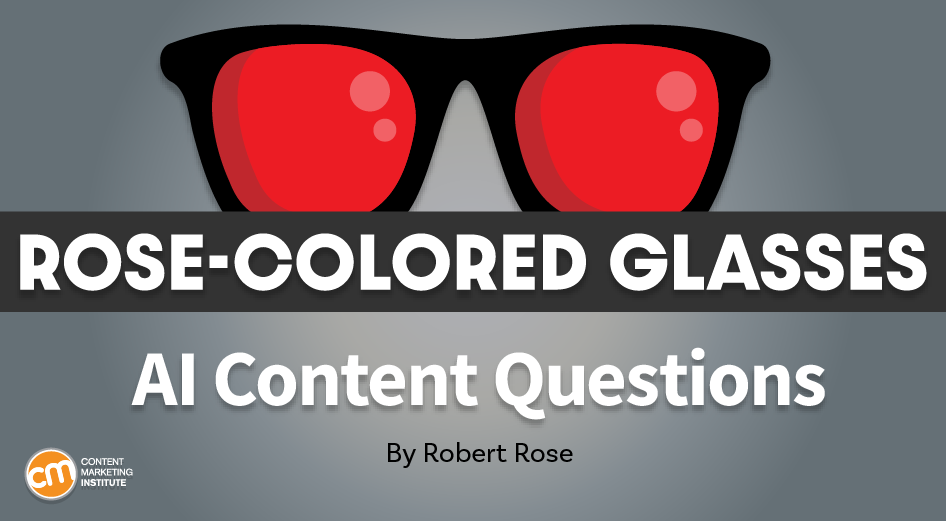MARKETING
3 Questions About AI in Content: What? So What? Now What?

In the United States, Thanksgiving will give us the needed break to take a collective breath.
I don’t know about you, but getting my bearings around the disruptions of generative AI presents an extreme challenge. Innovations come so quickly that once we think we have our arms around it, something new appears.
Almost one year into seeing what generative AI can do for content creation and marketing strategies, OpenAI has introduced custom GPTs for those who pay for access.
You can build custom ChatGPT applications to use the tool’s newest capabilities to do things specifically valuable to you. For example, your company could upload 10 years of blog articles and instruct the custom GPT to use the knowledge gained from the content to formulate answers to questions on the blogs’ topics. In theory, you get the depth and breadth of ChatGPT’s large language learning model focused on your knowledge base and able to take specific actions, such as sending an email or automating a task.
Impressive. But sheesh. What does that do to your plans to integrate tools into your marketing workflow? It seems like one of a hundred things that you’re supposed to pay attention to right now.
Time to reflect
If your time frees up this week either because of the holiday or because the Americans are on holiday, take a moment and reflect on these disruptions to your current marketing and content efforts.
A little more than 20 years ago, a nursing professor at Swansea University published a helpful framework for self-reflection and communication. His exercise has helped me in times of disruption, and perhaps it can be for you as well.
Answer a few questions that fall into three stages – what, so what, and now what?
- What? Describe what has happened simply and objectively – without judgment or interpretation. Some helpful prompts: What happened? What did you observe? What events occurred? What is the current situation?
- So what? Answer questions about what you know now that you didn’t know. You can introduce emotions. Some helpful prompts: What did you learn? What difference have the events made? Answer as yourself or within the context of your team or company.
If it’s just you, potential questions could be: Did what happened clarify an interest? Did you hear or feel anything that surprised you? How is your experience different than what you expected? What do these events mean to you?
If you answer on behalf of a team or group, you can ask the self-questions along with these prompts: What do these events suggest to you about this group? How might the group work better or worse with these events? How were decisions made or not made based on these events?
- Now what? Reflect on your future actions based on the first two steps. These broader implications react to what happened. Questions center on defining and looking at the root cause: What would contribute to a successful response? What would be in the way of successfully navigating through this? What learning has now occurred, and how can I/we apply this learning?
Ask your team to do this same exercise. When you meet back up, create a workshop or team gathering where you discuss the answers and determine where opportunities may exist.
Real reflections aren’t hot takes
If you find yourself thinking that process is basic, well, you’re right. These three questions – and the provocations that come from them – mirror a progression you’ve all tried to work through a problem. However, you don’t often do it for big disruptions in the moment. It’s just too easy to jump to the third step, “now what,” and confuse it with “what’s next.” You get overwhelmed by all the actions you can take.
You can see this challenge happening with the disruption of generative AI.
Check out this article that reflects on the disruption of generative AI in the video game industry. To make the case, it leverages Bain & Company research that “more than half of video game development process will be supported by generative AI within the next five to 10 years.” It uses “what happened” to make a case for “what’s next.” The author didn’t even bother to ask “so what” to reach the conclusion: “Microsoft wants AI to solve problems that game makers say they won’t actually have.”
If you reflect on what the Bain research actually said, you can see it’s almost the opposite of the Microsoft conclusion. The research plainly says few executives believe AI will reduce development costs. They say AI will not significantly impact talent and “do not believe it will replace the creative spark necessary for game development.”
By misinterpreting what happened and not asking, “So what,” the author jumped to predicting what’s next, which is almost useless to make any productive change to address what’s really happening.
This is why working through this process is helpful.
Now, to be clear, hot takes are fun. I’m not suggesting you do away with predictions or the occasional response. Hot takes are a great way to start the conversation, not to finish them.
Take the time – and the process – to work it out. It’s not perfect. It’s also not meant to be a fail-safe way to predict the future. The three-question stages are meant to help you balance facts and feelings to make more productive and satisfying responses to the disruptions you face.
The process is meant to change your future, not by helping you see it more clearly but by helping you clearly see how you change it.
It’s your story. Have a wonderful, reflective Thanksgiving, and tell it well.
Cover image by Joseph Kalinowski/Content Marketing Institute


















